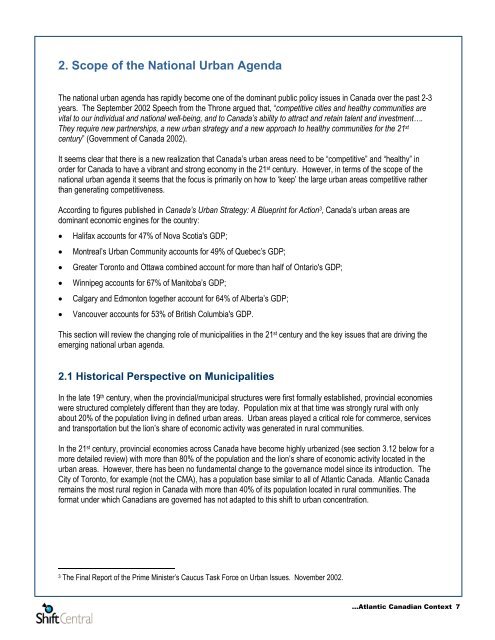Atlantic Canada's Urban Growth Agenda - Greater Halifax Partnership
Atlantic Canada's Urban Growth Agenda - Greater Halifax Partnership
Atlantic Canada's Urban Growth Agenda - Greater Halifax Partnership
Create successful ePaper yourself
Turn your PDF publications into a flip-book with our unique Google optimized e-Paper software.
2. Scope of the National <strong>Urban</strong> <strong>Agenda</strong><br />
The national urban agenda has rapidly become one of the dominant public policy issues in Canada over the past 2-3<br />
years. The September 2002 Speech from the Throne argued that, “competitive cities and healthy communities are<br />
vital to our individual and national well-being, and to Canada’s ability to attract and retain talent and investment….<br />
They require new partnerships, a new urban strategy and a new approach to healthy communities for the 21 st<br />
century” (Government of Canada 2002).<br />
It seems clear that there is a new realization that Canada’s urban areas need to be “competitive” and “healthy” in<br />
order for Canada to have a vibrant and strong economy in the 21 st century. However, in terms of the scope of the<br />
national urban agenda it seems that the focus is primarily on how to ‘keep’ the large urban areas competitive rather<br />
than generating competitiveness.<br />
According to figures published in Canada’s <strong>Urban</strong> Strategy: A Blueprint for Action 3 , Canada’s urban areas are<br />
dominant economic engines for the country:<br />
• <strong>Halifax</strong> accounts for 47% of Nova Scotia's GDP;<br />
• Montreal’s <strong>Urban</strong> Community accounts for 49% of Quebec’s GDP;<br />
• <strong>Greater</strong> Toronto and Ottawa combined account for more than half of Ontario's GDP;<br />
• Winnipeg accounts for 67% of Manitoba’s GDP;<br />
• Calgary and Edmonton together account for 64% of Alberta’s GDP;<br />
• Vancouver accounts for 53% of British Columbia's GDP.<br />
This section will review the changing role of municipalities in the 21 st century and the key issues that are driving the<br />
emerging national urban agenda.<br />
2.1 Historical Perspective on Municipalities<br />
In the late 19 th century, when the provincial/municipal structures were first formally established, provincial economies<br />
were structured completely different than they are today. Population mix at that time was strongly rural with only<br />
about 20% of the population living in defined urban areas. <strong>Urban</strong> areas played a critical role for commerce, services<br />
and transportation but the lion’s share of economic activity was generated in rural communities.<br />
In the 21 st century, provincial economies across Canada have become highly urbanized (see section 3.12 below for a<br />
more detailed review) with more than 80% of the population and the lion’s share of economic activity located in the<br />
urban areas. However, there has been no fundamental change to the governance model since its introduction. The<br />
City of Toronto, for example (not the CMA), has a population base similar to all of <strong>Atlantic</strong> Canada. <strong>Atlantic</strong> Canada<br />
remains the most rural region in Canada with more than 40% of its population located in rural communities. The<br />
format under which Canadians are governed has not adapted to this shift to urban concentration.<br />
3 The Final Report of the Prime Minister’s Caucus Task Force on <strong>Urban</strong> Issues. November 2002.<br />
…<strong>Atlantic</strong> Canadian Context 7





